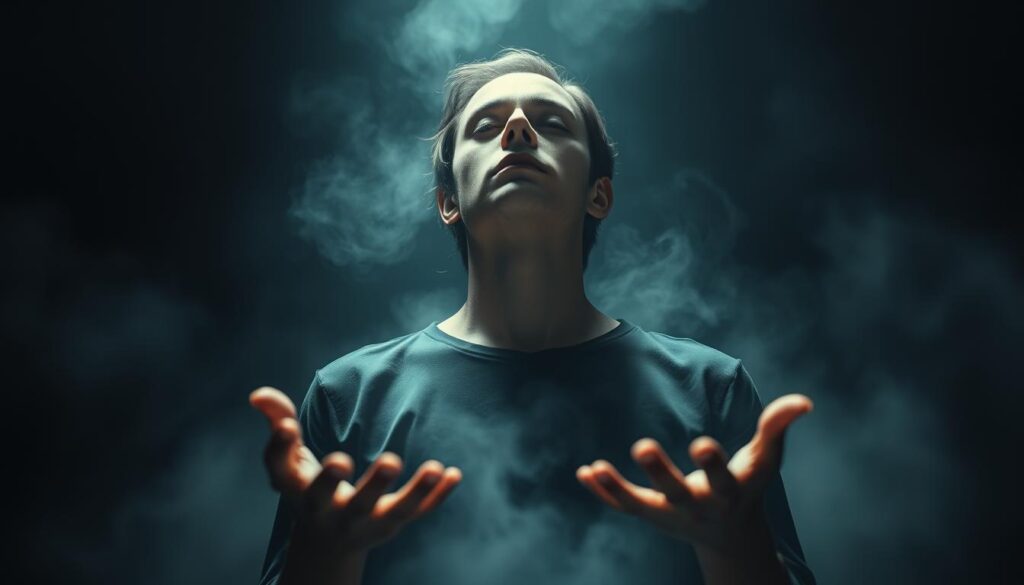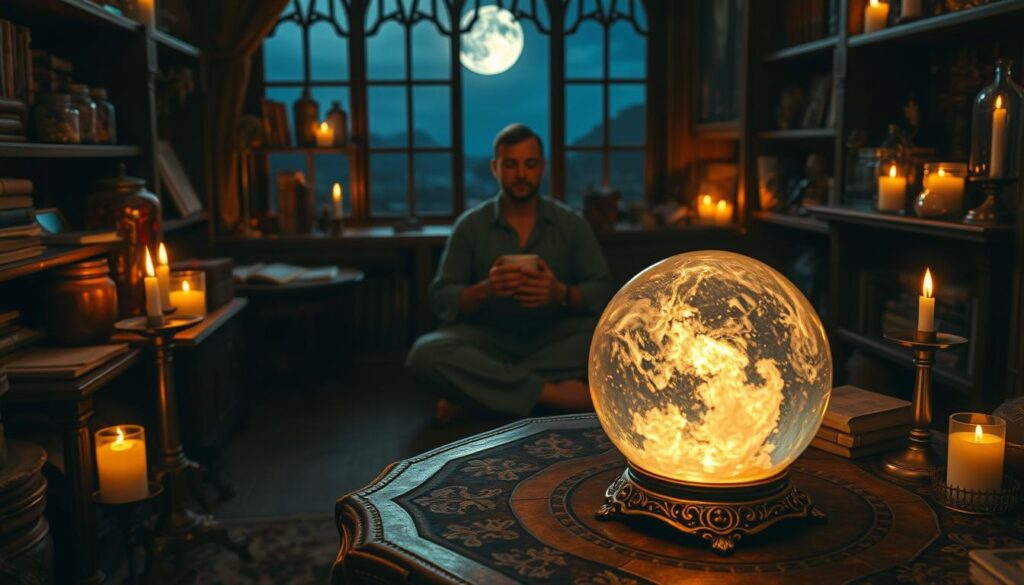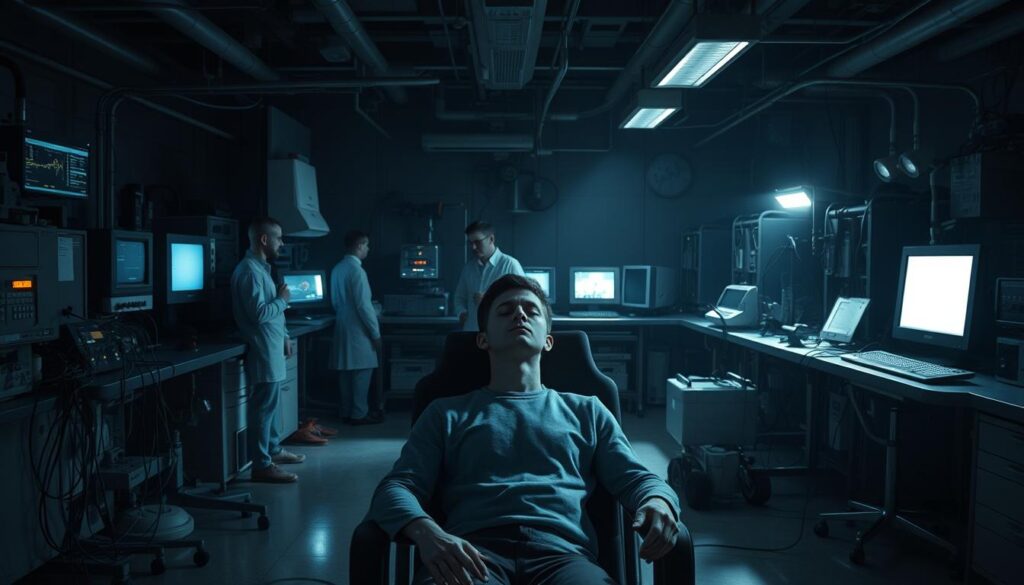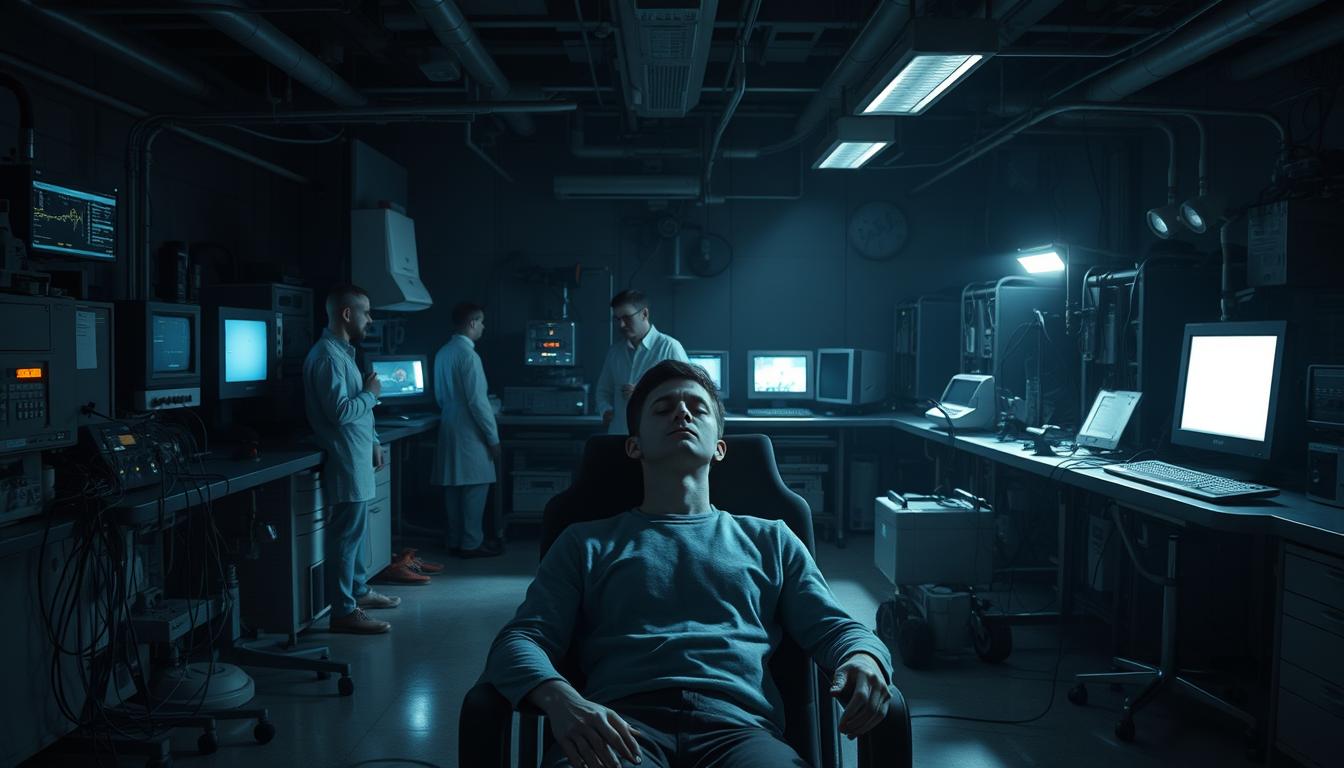For centuries, people who can see the future have been a big deal. Known as seers, they’ve amazed and puzzled us. They’ve helped shape our cultures and made big decisions for us.

Being a seer isn’t just about predicting the future. It’s like living in two worlds at once. They see what’s happening now and what’s coming. It’s a heavy burden to carry.
What’s so interesting about seeing the future is how it touches many areas. Some want proof from science, while others believe in its power. This debate keeps our interest in the future alive today.
Key Takeaways
- Seers have existed across all cultures and throughout human history
- Future sight manifests in various forms, from dreams to waking visions
- Living with precognitive abilities presents unique personal challenges
- Both skepticism and belief surround the phenomenon of seeing the future
- The ethical implications of foreknowledge create complex dilemmas
- Modern science continues to investigate potential explanations for precognition
The Ancient Art of Seeing Beyond Time
Humans have always been curious about the future. Long before we had modern tech, people tried to see what was coming. They used future sight techniques to understand tomorrow.
Origins of Future Sight in Early Civilizations
In Mesopotamia, people looked at the stars and animal organs for clues around 3000 BCE. In China, they used turtle shells to get messages from ancestors. Egyptian priests and Maya shamans also had their ways of seeing the future.
How Seers Were Revered Throughout History
The role of ancient seers changed across cultures. In Greece, Tiresias, a blind prophet, advised leaders. Persian magi used astrology to guide kings. Celtic druids were both respected and feared for their visions.
The Evolution of Divination Practices
As societies grew, so did their divination practices. Simple methods like bone-casting evolved into complex systems. The I Ching and tarot cards are examples of this evolution. Each method showed a culture’s view of the future.
| Culture | Divination Method | Materials Used |
|---|---|---|
| Mesopotamian | Hepatoscopy | Animal livers |
| Greek | Ornithomancy | Bird flight patterns |
| Chinese | I Ching | Yarrow stalks or coins |
| Celtic | Tasseography | Tea leaves |
What Makes Someone a Person Who Can See the Future?
People with precognitive abilities have traits that make them unique. They have a heightened intuition that lets them sense future events. They might feel goosebumps or a sudden change in temperature when they get glimpses of what’s to come.
Being sensitive to energies is another common trait. These individuals can pick up on subtle changes in their surroundings and the people around them. This sensitivity often starts in childhood, with many seers recalling unusual experiences from a young age.
Studies have found interesting differences in the brains of those with precognitive abilities. The prefrontal cortex and temporal lobes show unusual activity during prediction episodes. Some think these differences might be genetic, as psychic traits often run in families.
The visions come without warning – like memories, but of things that haven’t happened yet. They feel as real as remembering yesterday’s breakfast, except they’re showing me tomorrow’s dinner.
Many with prediction gifts can enter altered consciousness states. This can happen through meditation, dreamwork, or trance states. While some doubt these experiences, those with precognitive abilities often make accurate predictions. This suggests there’s something real behind these abilities.
The Different Types of Precognitive Abilities
Precognitive abilities come in many forms, each with its own traits and triggers. People who see the future use different ways to get these gifts. They can see visions in sleep or be aware of them while awake. Knowing these paths helps us understand how seers get their insights.
Dream Visions and Sleep Prophecies
Dream visions happen when we’re asleep and our minds are open. These dreams are clear, emotional, and often repeated. Seers remember these dreams vividly and know they’re important.
Unlike regular dreams, these visions stay sharp for a long time. They often include details about people and places the dreamer has never seen.
Waking Premonitions and Intuitive Flashes
Premonitions happen when we’re awake, showing up as sudden feelings or visions. These moments can feel like goosebumps or a gut feeling. Some seers see brief mental movies while they’re awake.
These moments can also cause physical reactions like a racing heart. The information comes fully formed, without the seer looking for it.
Remote Viewing and Time Displacement
Remote viewing lets seers see distant events without being there. This skill was studied during the Cold War. It allows seers to mentally visit places and see what’s happening there.
Time displacement is the most advanced form of seeing the future. Practitioners feel like they’re in another time, seeing events up close. This method gives a full, sensory experience of the future.
Famous Seers Throughout History and Their Predictions
Throughout history, some people have been known for seeing the future. These visionaries have shaped the world with their mysterious insights. Their prophecies vary from vague to specific, with mixed results in accuracy.
Nostradamus and His Quatrains
In the 16th century, Michel de Nostredame, known as Nostradamus, wrote prophecies that have amazed readers for centuries. His cryptic verses predicted events like the Great Fire of London and Napoleon’s rise. These enigmatic texts are still debated today.
“The young lion will overcome the old one, on the field of battle in single combat: He will pierce his eyes in a golden cage, two fleets one, then to die a cruel death.” – Nostradamus, Century 1, Quatrain 35
The Oracle of Delphi’s Influence on Ancient Greece
The Oracle of Delphi was the spiritual heart of ancient Greece for nearly 1,000 years. People from all walks of life went there for prophecies. The Pythia, a priestess in a trance, gave cryptic messages that guided everything from wars to personal decisions.
The Oracle famously warned Croesus of Lydia about attacking Persia. She said it would destroy a great empire—his own.
Modern-Day Prophets and Their Accuracy Rates
In today’s world, seers face intense scrutiny. Edgar Cayce made detailed medical diagnoses while in trance. Jeane Dixon predicted JFK’s assassination, among other things. Analysts use statistics to measure their accuracy, showing wide variations.
| Seer | Period | Prophecy Accuracy | Notable Predictions |
|---|---|---|---|
| Nostradamus | 16th Century | Debated (20-70%) | Great Fire, World Wars |
| Oracle of Delphi | Ancient Greece | Undetermined | Battle outcomes, dynastic changes |
| Edgar Cayce | 20th Century | ~80% (medical readings) | Health diagnoses, Earth changes |
The Science Behind Precognition
For thousands of years, seers and prophets have claimed to see the future. Today, parapsychology research uses science to test this idea. Scientists use special tests to see if people can really know what’s going to happen before it does.
At Princeton University, the Princeton Engineering Anomalies Research lab worked for nearly three decades. They did experiments to see if precognition was real. Their results showed small signs that something might be moving through time in a way we don’t understand.
The data suggests that consciousness may interact with events in ways not limited by our conventional understanding of time and causality.
Dr. Dean Radin studied how our bodies react before we see emotional pictures. He found that our bodies can react 3-5 seconds before we see the pictures. It’s as if our bodies are sensing what’s coming.
The Global Consciousness Project is another interesting study. It uses random number generators around the world to see if they change before big events. Even though some scientists are still unsure, the evidence is strong. It makes us think about time and consciousness in new ways.
Living With the Gift: Daily Challenges Seers Face
Being a seer is more than just seeing the future. It’s a daily battle that most people don’t see. Seers deal with visions that pop up without warning, changing their plans and demanding their full attention.

Managing Unexpected Visions
Seers find ways to handle visions that come out of nowhere. They use grounding exercises like deep breathing or touching the earth. Keeping a journal helps them understand their visions better and plan for the unexpected.
- Creating safe spaces for when visions occur
- Developing code words to alert trusted companions
- Establishing daily meditation routines
The Emotional Toll of Foreseeing Tragedy
Seeing future tragedies is hard on a seer’s mind. They often see things they can’t stop, leading to feelings of helplessness. This constant worry is a big challenge for seers, requiring strength and resilience.
Building Relationships When You Know Too Much
Having future insights makes relationships tricky. In love, knowing what’s coming can be hard for both partners. Friends might feel uneasy knowing what’s ahead for them. This isolation adds to the burden seers already carry.
| Seer Challenge | Coping Strategy |
|---|---|
| Unexpected visions | Grounding techniques, safe spaces |
| Emotional distress | Therapy, support groups |
| Relationship difficulties | Communication boundaries, disclosure protocols |
How Seers Hone Their Abilities
Developing precognition starts with noticing small signals from your intuition. People with natural foresight often see their hunches or dreams come true. These early signs help build their skills.
Daily meditation is key in psychic training. Spend 15 minutes each morning to clear your mind. It’s better to meditate regularly, even for short periods, than to do it for long stretches.
Keeping a prediction journal is helpful. Write down your impressions without judgment. Note the date, time, and details. Look over your entries weekly to find patterns.
Experienced seers suggest these exercises:
- Symbol work: visualize simple shapes and practice receiving information through them
- Remote viewing drills using sealed envelopes containing unknown objects
- Dream incubation by setting clear intentions before sleep
Finding a mentor can really help you grow. Many experienced seers are happy to guide newcomers through the early stages of psychic development.
The difference between random psychic experiences and reliable precognition is simply practice, patience, and proper training techniques.
To improve your intuition, learn to tell true precognitive signals from your imagination. This skill comes from testing your impressions against real outcomes and getting better over time.
The Ethical Dilemmas of Knowing the Future
Looking into the future raises big moral questions. Those who can see ahead face a tough choice. They must decide whether to act or hold back, all while questioning their gifts.
To Intervene or Not: The Butterfly Effect
Should a seer try to stop a tragedy? The butterfly effect shows that small actions can have big effects. A warning might save lives but also cause new problems. Seers struggle with this every day, weighing the need to act against the risk of chaos.
Some visions are hard to ignore – like a child in danger or an impending disaster. Those who see these things feel the weight of their choices.
The Responsibility of Sharing Predictions
Deciding what to share is tough. Timing and certainty are key. Sharing too early can cause panic, while sharing too late might be useless.
Do you have the right to keep knowledge that could save lives? But what harm could come from sharing predictions that never happen?
Seers must think about who needs to know and how much to tell. They also wonder if their visions are set in stone or can change.
When Foreknowledge Becomes a Burden
The mental strain is huge. Imagine seeing disasters twice – first in a vision, then in real life. Many seers feel guilty when they can’t change what’s coming.
This weight changes seers. Some pull away from others, fearing pain. Others try hard to change the course of events. Finding a balance between accepting what’s to come and trying to change it is their biggest challenge.
Skepticism and Validation: Testing Future-Seeing Abilities
Trying to prove that some people can see the future is a mix of faith and proof. Scientists have made strict tests to see if these claims are real. They record predictions before they happen to avoid any tricks.
In labs, tests are done in a controlled way. People might guess random card sequences or future news. The goal is to see if their guesses are better than chance.

But, skeptics find that psychology plays a big role. People tend to remember when they’re right and forget when they’re wrong. The Barnum effect makes vague statements seem personal. To avoid this, tests are done blind, where judges don’t know who made what prediction.
The Rhine Research Center and Princeton Engineering Anomalies Research lab have led the way in studying psychic phenomena. They found that while big predictions are hard to prove, small changes in large data sets might show something. This hints that psychic abilities could be real, but not as dramatic as we think.
Real psychics usually want to be tested. They see it as a way to understand their gifts, not just to prove them. The best cases are those where results are consistent and open to strict testing.
Cultural Representations of Seers in Literature and Media
Throughout history, people with the gift of foresight have fascinated us. They appear in many stories and cultural works. These portrayals range from serious to funny, mystical to scientific. They shape how we see precognitive abilities in real life.
Prophets and Oracles in Ancient Texts
Ancient civilizations respected their seers deeply. Oracle mythology is key in many classic stories. From Tiresias in Greek tales to the Sibylline Books in Rome, these figures are enigmatic yet powerful.
The Delphic Oracle is famous. Priestesses there gave cryptic prophecies that influenced wars, dynasties, and fortunes.
Psychics in Popular Movies and TV Shows
Today’s movies and TV shows feature psychics in new ways. Minority Report shows precogs helping law enforcement. Shows like Medium and The Dead Zone delve into the personal struggles of those with visions.
Media portrays seers as heroes, tragic figures, or even comedians. In horror, psychic friends often face danger. Detective shows feature intuitive consultants solving tough cases.
How Fiction Shapes Our Perception of Precognition
Fictional psychics in stories shape our views on real precognition. Dramatic visions and altered voices are what many expect. These elements add to the mystique of precognition.
Our love for stories about future-seers shows our curiosity about fate and free will. Whether we doubt or believe, these stories enrich our understanding of precognition.
Finding Your Own Intuitive Abilities
The journey to develop intuition begins with understanding that everyone has a spectrum of gifts. Many overlook their gut feelings, thinking they’re just luck. But, they might actually have hidden psychic abilities waiting to be discovered.
Just like physical exercise, your intuition gets stronger with practice. Start with these easy exercises that need no special skills:
- Before checking your phone, guess who might have messaged you
- Place three cups upside down, hide an object under one, shuffle them, then sense which contains the item
- Keep a dream journal beside your bed to capture insights that fade quickly upon waking
- Spend five minutes in silent meditation daily, noting any impressions that arise
Trust the small voice within that speaks without words. The quieter you become, the clearer you will hear it.
Be patient with these practices, not impatient. It’s not about becoming a famous psychic. It’s about improving your natural awareness. Even small improvements can lead to better decisions and deeper connections.
Conclusion: Embracing the Mystery of Future Sight
As we wrap up our look at future sight and precognitive phenomena, it’s clear that the world of psychic abilities still fascinates us. From ancient Greece’s oracles to today’s psychics, our interest in seeing the future has never faded. It spans cultures and centuries.
The case for future sight is strong, but we must stay critical and open-minded. As we learn more about our minds and consciousness, we might find new ways to understand precognition. Until then, we should be cautious but also respect those who claim to see the future.
The enigma of future sight shows us how much we still don’t know about our world. By keeping an open mind and valuing scientific proof, we can delve deeper into our own intuition. This journey takes us beyond what we know today.
FAQ
What is the difference between a person who can see the future and someone with heightened intuition?
A person who can see the future often has vivid visions of what’s to come. They might have prophetic dreams or extrasensory premonitions. On the other hand, someone with heightened intuition might feel a strong gut instinct about future events. But their information is usually more subtle and less specific than a true seer’s.
How do seers throughout history differ in their methods and abilities?
Seers have used many ways to see the future, from ancient animal entrails to modern tarot. Their abilities vary, with some getting visions and others dreaming of the future. Yet, they’re all seen as spiritual guides, respected for their connection to the unknown.
What are some of the ethical dilemmas that seers face in their daily lives?
Seers often face tough choices, like whether to prevent future tragedies. They must decide how to share their visions and deal with the emotional weight of knowing what’s to come. The fear of causing panic or the burden of foreseeing suffering can be overwhelming.
How do researchers and skeptics approach the scientific study of precognition?
Scientists are skeptical about precognition, needing solid proof to believe it. They’ve tried various tests, like lab studies and analyzing prediction accuracy. But, the subjective nature of these abilities makes it hard to prove them scientifically. Despite some interesting findings, many scientists remain skeptical until more evidence comes along.
What are some practical steps individuals can take to develop their own intuitive abilities?
Want to tap into your intuition? Start with meditation to improve your focus. Keep a journal to track your gut feelings. Try simple prediction games to see if you can guess the future. The goal is to trust your instincts and grow, even if you don’t become a full-fledged seer.
